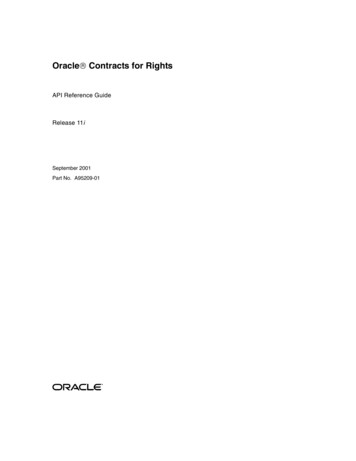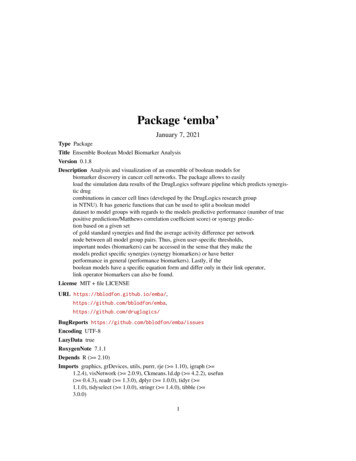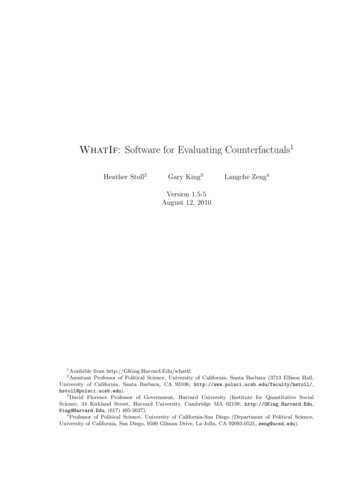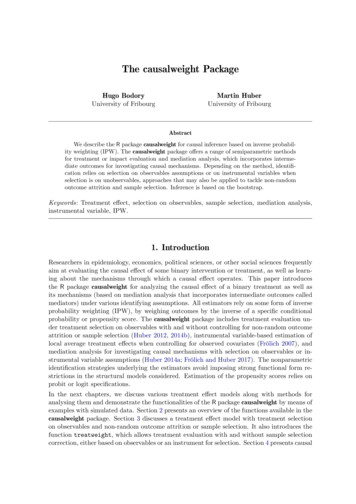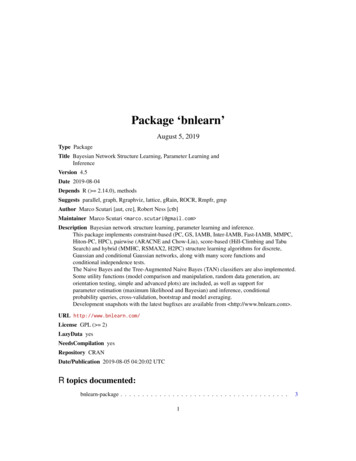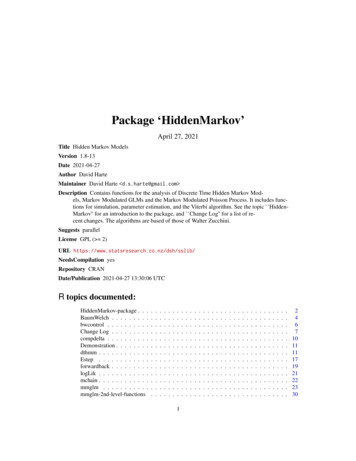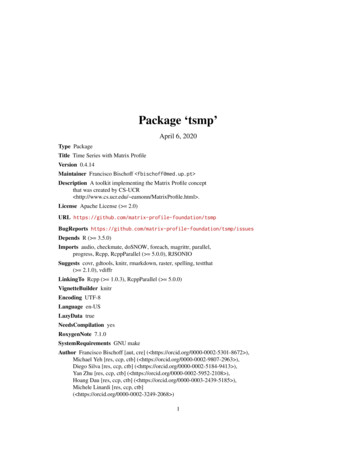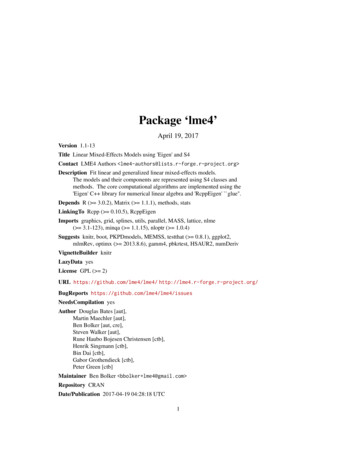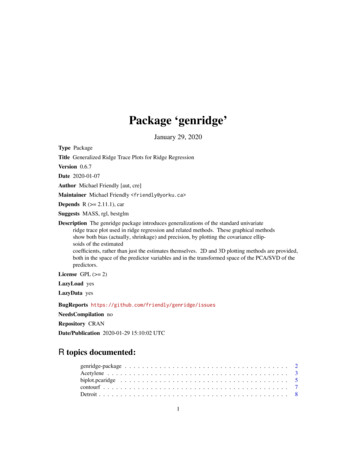
Transcription
Package ‘genridge’January 29, 2020Type PackageTitle Generalized Ridge Trace Plots for Ridge RegressionVersion 0.6.7Date 2020-01-07Author Michael Friendly [aut, cre]Maintainer Michael Friendly friendly@yorku.ca Depends R ( 2.11.1), carSuggests MASS, rgl, bestglmDescription The genridge package introduces generalizations of the standard univariateridge trace plot used in ridge regression and related methods. These graphical methodsshow both bias (actually, shrinkage) and precision, by plotting the covariance ellipsoids of the estimatedcoefficients, rather than just the estimates themselves. 2D and 3D plotting methods are provided,both in the space of the predictor variables and in the transformed space of the PCA/SVD of thepredictors.License GPL ( 2)LazyLoad yesLazyData yesBugReports mpilation noRepository CRANDate/Publication 2020-01-29 15:10:02 UTCR topics documented:genridge-packageAcetylene . . . .biplot.pcaridge .contourf . . . . .Detroit . . . . . .1.23578
2genridge-packageManpower .pairs.ridge .pca.ridge . .plot.ridge .plot3d.ridgeprecision . .prostate . .ridge . . . .traceplot . .trans.colorsvif.ridge . eralized ridge trace plots for ridge regressionDescriptionThe genridge package introduces generalizations of the standard univariate ridge trace plot used inridge regression and related methods (Friendly, 2012). These graphical methods show both bias (actually, shrinkage) and precision, by plotting the covariance ellipsoids of the estimated coefficients,rather than just the estimates themselves. 2D and 3D plotting methods are provided, both in thespace of the predictor variables and in the transformed space of the PCA/SVD of the e:LazyLoad:genridgePackage0.6-72020-01-07GPL version 2 or neweryesThis package provides computational support for the graphical methods described in Friendly(2013). Ridge regression models may be fit using the function ridge, which incorporates features of lm.ridge. In particular, the shrinkage factors in ridge regression may be specified either interms of the constant added to the diagonal of X T X matrix (lambda), or the equivalent number ofdegrees of freedom.More importantly, the ridge function also calculates and returns the associated covariance matricesof each of the ridge estimates, allowing precision to be studied and displayed graphically.This provides the support for the main plotting functions in the package:plot.ridge: Bivariate ridge trace plotspairs.ridge: All pairwise bivariate ridge trace plots
Acetylene3plot3d.ridge: 3D ridge trace plotstraceplot: Traditional univariate ridge trace plotsIn addition, the function pca.ridge transforms the coefficients and covariance matrices of a ridgeobject from predictor space to the equivalent, but more interesting space of the PCA of X T X or theSVD of X. The main plotting functions also work for these objects, of class c("ridge","pcaridge").Finally, the functions precision and vif.ridge provide other useful measures and plots.Author(s)Michael FriendlyMaintainer: Michael Friendly friendly@yorku.ca ReferencesFriendly, M. (2013). The Generalized Ridge Trace Plot: Visualizing Bias and Precision. Journal ofComputational and Graphical Statistics, 22(1), 50-68, doi:10.1080/10618600.2012.681237, ge.pdfArthur E. Hoerl and Robert W. Kennard (1970). Ridge Regression: Biased Estimation for Nonorthogonal Problems, Technometrics, 12(1), pp. 55-67.Arthur E. Hoerl and Robert W. Kennard (1970). Ridge Regression: Applications to NonorthogonalProblems Technometrics, 12(1), pp. 69-82.See Alsolm.ridgeExamples# see examples for ridge, etc.AcetyleneAcetylene DataDescriptionThe data consist of measures of yield of a chemical manufacturing process for acetylene in relationto numeric parameters.Marquardt and Snee (1975) used these data to illustrate ridge regression in a model containingquadratic and interaction terms, particularly the need to center and standardize variables appearingin high-order terms.Usagedata(Acetylene)
4AcetyleneFormatA data frame with 16 observations on the following 4 variables.yield conversion percentage yield of acetylenetemp reactor temperature (celsius)ratio H2 to N-heptone ratiotime contact time (sec)DetailsTypical models for these data include the interaction of temp:ratio, and a squared term in tempSourceSAS documentation example for PROC REG, Ridge Regression for Acetylene Data.ReferencesMarquardt, D.W., and Snee, R.D. (1975), "Ridge Regression in Practice," The American Statistician, 29, 3-20.Marquardt, D.W. (1980), "A Critique of Some Ridge Regression Methods: Comment," Journal ofthe American Statistical Association, Vol. 75, No. 369 (Mar., 1980), pp. 87-91Examplesdata(Acetylene)# naive model, not using centeringamod0 - lm(yield temp ratio time I(time 2) temp:time, data Acetylene)y - Acetylene[,"yield"]X0 - model.matrix(amod0)[,-1]lambda - c(0, 0.0005, 0.001, 0.002, 0.005, 0.01)aridge0 - ridge(y, X0, lambda lambda)traceplot(aridge0)traceplot(aridge0, X "df")pairs(aridge0, radius 0.2)
biplot.pcaridgebiplot.pcaridge5Biplot of Ridge Regression Trace Plot in SVD SpaceDescriptionbiplot.pcaridge supplements the standard display of the covariance ellipsoids for a ridge regression problem in PCA/SVD space with labeled arrows showing the contributions of the originalvariables to the dimensions plotted.The biplot view showing the dimensions corresponding to the two smallest singular values is particularly useful for understanding how the predictors contribute to shrinkage in ridge regression.This is only a biplot in the loose sense that results are shown in two spaces simultaneously – thetransformed PCA/SVD space of the original predictors, and vectors representing the predictorsprojected into this space.biplot.ridge is a similar extension of plot.ridge, adding vectors showing the relation of thePCA/SVD dimensions to the plotted variables.Usage## S3 method for class 'pcaridge'biplot(x, variables (p - 1):p, labels NULL, asp 1,origin, scale,var.lab rownames(V), var.lwd 1, var.col "black", var.cex 1,xlab, ylab, prefix "Dim ", suffix TRUE, .)## S3 method for class 'ridge'biplot(x, variables 1:2, xlab, ylab, .)ArgumentsxA pcaridge object computed by pca.ridge or a ridge object.variablesThe dimensions or variables to be shown in the the plot. By default, the lasttwo dimensions, corresponding to the smallest singular values, are plotted forclass("pcaridge") objects or the first two variables for class("ridge") objects.labelsA vector of character strings or expressions used as labels for the ellipses. Uselabels NULL to suppress these.aspAspect ratio for the plot. The default value, asp 1 helps ensure that lengths andangles are preserved in these plots. Use asp NA to override this.originThe origin for the variable vectors in this plot, a vector of length 2. If not specified, the function calculates an origin to make the variable vectors approximatelycentered in the plot window.scaleThe scale factor for variable vectors in this plot. If not specified, the functioncalculates a scale factor to make the variable vectors approximately fill the plotwindow.
6biplot.pcaridgevar.labLabels for variable vectors. The default is the names of the predictor variables.var.lwd, var.col, var.cexLine width, color and character size used to draw and label the arrows representing the variables in this plot.xlab, ylabLabels for the plot dimensions. If not specified, prefix and suffix are used toconstruct informative dimension labels.prefixPrefix for labels of the plot dimensions.suffixSuffix for labels of the plot dimensions. If suffix TRUE the percent of varianceaccounted for by each dimension is added to the axis label.Other arguments, passed to plot.pcaridgeDetailsclass("ridge") objects use the transpose of the right singular vectors, t(x svd.V) for the dimension weights plotted as vectors.ValueNoneAuthor(s)Michael Friendly, with contributions by Uwe LiggesReferencesFriendly, M. (2012). The Generalized Ridge Trace Plot: Visualizing Bias and Precision. In press,Journal of Computational and Graphical Statistics, 21.See Alsoplot.ridge, pca.ridgeExampleslongley.y - longley[, "Employed"]longley.X - data.matrix(longley[, c(2:6,1)])lambda - c(0, 0.005, 0.01, 0.02, 0.04, 0.08)lridge - ridge(longley.y, longley.X, lambda lambda)plridge - pca.ridge(lridge)plot(plridge, radius 0.5)# same, with variable vectorsbiplot(plridge, radius 0.5)# add some other optionsbiplot(plridge, radius 0.5, var.col "brown", var.lwd 2, var.cex 1.2, prefix "Dimension ")
contourf7# biplots for ridge objects, showing PCA vectorsplot(lridge, radius 0.5)biplot(lridge, radius 0.5)biplot(lridge, radius 0.5, asp NA)contourfEnhanced Contour PlotsDescriptionThis is an enhancement to contour, written as a wrapper for that function. It creates a contour plot,or adds contour lines to an existing plot, allowing the contours to be filled and returning the list ofcontour lines.Usagecontourf(x seq(0, 1, length.out nrow(z)), y seq(0, 1, length.out ncol(z)), z,nlevels 10, levels pretty(zlim, nlevels),zlim range(z, finite TRUE),col par("fg"),color.palette colorRampPalette(c("white", col)),fill.col color.palette(nlevels 1),fill.alpha 0.5,add FALSE, .)Argumentsx, ylocations of grid lines at which the values in z are measured. These must be inascending order. By default, equally spaced values from 0 to 1 are used. If x isa list, its components x x and x y are used for x and y, respectively. If the listhas component x z this is used for z.za matrix containing the values to be plotted (NAs are allowed). Note that x canbe used instead of z for convenience.nlevelsnumber of contour levels desired iff levels is not suppliedlevelsnumeric vector of levels at which to draw contour lineszlimz-limits for the plot. x-limits and y-limits can be passed through . . .colcolor for the lines drawncolor.palettea color palette function to be used to assign fill colors in the plotfill.cola call to the color.palette function or an an explicit set of colors to be usedin the plot. Use fill.col NULL to suppress the filled polygons. a vector of fillcolors corresponding to levels. By default, a set of possibly transparent colors iscalculated ranging from white to col, using transparency given by fill.alphafill.alphatransparency value for fill.col, either a hex character string, or a numericvalue between 0 and 1. Use fill.alpha NA to suppress transparency.
8Detroitaddlogical. If TRUE, add to a current plot.additional arguments passed to contour, including all arguments of contour.defaultnot mentioned above, as well as additional graphical parameters passed by contour.defaultto more basic functions.ValueReturns invisibly the list of contours lines, with components levels, x, y. See contourLines.Author(s)Michael FriendlySee Alsocontour, contourLinescontourplot from package lattice.Examplesx - 10*1:nrow(volcano)y - 10*1:ncol(volcano)contourf(x,y,volcano, col "blue")contourf(x,y,volcano, col "blue", nlevels 6)# return value, unfilled, other graphic parametersres - contourf(x,y,volcano, col "blue", fill.col NULL, lwd 2)# levels used in the plotsapply(res, function(x) x[[1]])DetroitDetroit Homicide Data for 1961-1973DescriptionThe data set Detroit was used extensively in the book by Miller (2002) on subset regression. Thedata are unusual in that a subset of three predictors can be found which gives a very much better fit tothe data than the subsets found from the Efroymson stepwise algorithm, or from forward selectionor backward elimination. They are also unusual in that, as time series data, the assumption ofindependence is patently violated, and the data suffer from problems of high collinearity.As well, ridge regression reveals somewhat paradoxical paths of shrinkage in univariate ridge traceplots, that are more comprehensible in multivariate views.Usagedata(Detroit)
Detroit9FormatA data frame with 13 observations on the following 14 variables.Police Full-time police per 100,000 populationUnemp Percent unemployed in the populationMfgWrk Number of manufacturing workers in thousandsGunLic Number of handgun licences per 100,000 populationGunReg Number of handgun registrations per 100,000 populationHClear Percent of homicides cleared by arrestsWhMale Number of white males in the populationNmfgWrk Number of non-manufacturing workers in thousandsGovWrk Number of government workers in thousandsHrEarn Average hourly earningsWkEarn Average weekly earningsAccident Death rate in accidents per 100,000 populationAssaults Number of assaults per 100,000 populationHomicide Number of homicides per 100,000 of populationDetailsThe data were orginally collected and discussed by Fisher (1976) but the complete dataset firstappeared in Gunst and Mason (1980, Appendix A). Miller (2002) discusses this dataset throughouthis book, but doesn’t state clearly which variables he used as predictors and which is the dependentvariable. (Homicide was the dependent variable, and the predictors were Police . . . WkEarn.) Thedata were obtained from StatLib.A similar version of this data set, with different variable names appears in the bestglm roitReferencesFisher, J.C. (1976). Homicide in Detroit: The Role of Firearms. Criminology, 14, 387–400.Gunst, R.F. and Mason, R.L. (1980). Regression analysis and its application: A data-orientedapproach. Marcel Dekker.Miller, A. J. (2002). Subset Selection in Regression. 2nd Ed. Chapman & Hall/CRC. Boca Raton.
10ManpowerExamplesdata(Detroit)# Work with a subset of predictors, from Miller (2002, Table 3.14),# the "best" 6 variable model#Variables: Police, Unemp, GunLic, HClear, WhMale, WkEarn# Scale these for comparison with other methodsDet - as.data.frame(scale(Detroit[,c(1,2,4,6,7,11)]))Det - cbind(Det, Homicide Detroit[,"Homicide"])# use the formula interface; specify ridge constants in terms# of equivalent degrees of freedomdridge - ridge(Homicide ., data Det, df seq(6,4,-.5))# univariate trace plots are seemingly paradoxical in that# some coefficients "shrink" *away* from 0traceplot(dridge, X "df")vif(dridge)pairs(dridge, radius 0.5)plot3d(dridge, radius 0.5, labels dridge df)# transform to PCA/SVD spacedpridge - pca.ridge(dridge)# not so paradoxical in PCA spacetraceplot(dpridge, X "df")biplot(dpridge, radius 0.5, labels dpridge df)# show PCA vectors in variable spacebiplot(dridge, radius 0.5, labels dridge df)ManpowerHospital manpower dataDescriptionThe hospital manpower data, taken from Myers (1990), table 3.8, are a well-known example ofhighly collinear data to which ridge regression and various shrinkage and selection methods areoften applied.The data consist of measures taken at 17 U.S. Naval Hospitals and the goal is to predict the requiredmonthly man hours for staffing purposes.Usagedata(Manpower)
Manpower11FormatA data frame with 17 observations on the following 6 variables.Hours monthly man hours (response variable)Load average daily patient loadXray monthly X-ray exposuresBedDays monthly occupied bed daysAreaPop eligible population in the area in thousandsStay average length of patient’s stay in daysDetailsMyers (1990) indicates his source was "Procedures and Analysis for Staffing Standards Development: Data/Regression Analysis Handbook", Navy Manpower and Material Analysis Center, SanDiego, 1979.SourceRaymond H. Myers (1990). Classical and Modern Regression with Applications, 2nd ed., PWSKent, pp. 130-133.ReferencesDonald R. Jensen and Donald E. Ramirez (2012). Variations on Ridge Traces in Regression, Communications in Statistics - Simulation and Computation, 41 (2), 265-278.See Alsomanpower for the same data, and other analysesExamplesdata(Manpower)mmod - lm(Hours ., data Manpower)vif(mmod)# ridge regression models, specified in terms of equivalent dfmridge - ridge(Hours ., data Manpower, df seq(5, 3.75, -.25))vif(mridge)# univariate ridge trace plotstraceplot(mridge)traceplot(mridge, X "df")# bivariate ridge trace plotsplot(mridge, radius 0.25, labels mridge df)pairs(mridge, radius 0.25)# 3D views
12pairs.ridge# ellipsoids for Load, Xray & BedDays are nearly 2Dplot3d(mridge, radius 0.2, labels mridge df)# variables in model selected by AIC & BICplot3d(mridge, variables c(2,3,5), radius 0.2, labels mridge df)# plots in PCA/SVD spacempridge - pca.ridge(mridge)traceplot(mpridge, X "df")biplot(mpridge, radius 0.25)pairs.ridgeScatterplot Matrix of Bivariate Ridge Trace PlotsDescriptionDisplays all possible pairs of bivariate ridge trace plots for a given set of predictors.Usage## S3 method for class 'ridge'pairs(x, variables, radius 1, lwd 1, lty 1,col c("black", "red", "darkgreen", "blue","darkcyan", "magenta", "brown", "darkgray"),center.pch 16, center.cex 1.25, digits getOption("digits") - 3,diag.cex 2, diag.panel panel.label, fill FALSE, fill.alpha 0.3, .)ArgumentsxA ridge object, as fit by ridgevariablesPredictors in the model to be displayed in the plot: an integer or character vector,giving the indices or names of the variables.radiusRadius of the ellipse-generating circle for the covariance ellipsoids.lwd, ltyLine width and line type for the covariance ellipsoids. Recycled as necessary.colA numeric or character vector giving the colors used to plot the covariance ellipsoids. Recycled as necessary.center.pchPlotting character used to show the bivariate ridge estimates. Recycled as necessary.center.cexSize of the plotting character for the bivariate ridge estimatesfillLogical vector: Should the covariance ellipsoids be filled? Recycled as necessary.fill.alphaNumeric vector: alpha transparency value(s) for filled ellipsoids. Recycled asnecessary.digitsNumber of digits to be displayed as the (min, max) values in the diagonal panels
pairs.ridge13diag.cexCharacter size for predictor labels in diagonal panelsdiag.panelFunction to draw diagonal panels. Not yet implemented: just uses internalpanel.label to write the variable name and ranges.Other arguments passed downValueNone. Used for its side effect of plotting.Author(s)Michael FriendlyReferencesFriendly, M. (2013). The Generalized Ridge Trace Plot: Visualizing Bias and Precision. Journal ofComputational and Graphical Statistics, 22(1), 50-68, doi:10.1080/10618600.2012.681237, ge.pdfSee Alsoridge for details on ridge regression as implemented hereplot.ridge, traceplot for other plotting methodsExampleslongley.y - longley[, "Employed"]longley.X - data.matrix(longley[, c(2:6,1)])lambda - c(0, 0.005, 0.01, 0.02, 0.04, 0.08)lridge - ridge(longley.y, longley.X, lambda lambda)pairs(lridge, radius 0.5, diag.cex 1.75)data(prostate)py - prostate[, "lpsa"]pX - data.matrix(prostate[, 1:8])pridge - ridge(py, pX, df 8:1)pairs(pridge)
14pca.ridgepca.ridgeTransform Ridge Estimates to PCA SpaceDescriptionThe function pca.ridge transforms a ridge object from parameter space, where the estimatedcoefficients are βk with covariance matrices Σk , to the principal component space defined by theright singular vectors, V , of the singular value decomposition of the scaled predictor matrix, X.In this space, the transformed coefficients are V βk , with covariance matricesV Σk V TThis transformation provides alternative views of ridge estimates in low-rank approximations.Usagepca.ridge(x, .)ArgumentsxA ridge object, as fit by ridge.Other arguments passed down. Not presently used in this implementation.ValueAn object of class c("ridge","pcaridge"), with the same components as the original ridgeobject.Author(s)Michael FriendlyReferencesFriendly, M. (2013). The Generalized Ridge Trace Plot: Visualizing Bias and Precision. Journal ofComputational and Graphical Statistics, 22(1), 50-68, doi:10.1080/10618600.2012.681237, ge.pdfSee Alsoridge
plot.ridge15Exampleslongley.y - longley[, "Employed"]longley.X - data.matrix(longley[, c(2:6,1)])lambda - c(0, 0.005, 0.01, 0.02, 0.04, 0.08)lridge - ridge(longley.y, longley.X, lambda lambda)plridge - pca.ridge(lridge)traceplot(plridge)pairs(plridge)# view in space of smallest singular valuesplot(plridge, variables 5:6)plot.ridgeBivariate Ridge Trace PlotsDescriptionThe bivariate ridge trace plot displays 2D projections of the covariance ellipsoids for a set of ridgeregression estimates indexed by a ridge tuning constant.The centers of these ellipses show the bias induced for each parameter, and also how the change inthe ridge estimate for one parameter is related to changes for other parameters.The size and shapes of the covariance ellipses show directly the effect on precision of the estimatesas a function of the ridge tuning constant.Usage## S3 method for class 'ridge'plot(x, variables 1:2, radius 1, which.lambda 1:length(x lambda),labels lambda, pos 3, cex 1.2,lwd 2, lty 1, xlim, ylim,col c("black", "red", "darkgreen", "blue","darkcyan", "magenta", "brown", "darkgray"),center.pch 16, center.cex 1.5, fill FALSE, fill.alpha 0.3,ref TRUE, ref.col gray(.70), .)## S3 method for class 'pcaridge'plot(x, variables (p-1):p, labels NULL, .)ArgumentsxA ridge object, as fit by ridgevariablesPredictors in the model to be displayed in the plot: an integer or character vectorof length 2, giving the indices or names of the variables. Defaults to the first twopredictors for ridge objects or the last two dimensions for pcaridge objects.
16plot.ridgeradiusRadius of the ellipse-generating circle for the covariance ellipsoids. The default,radius 1 gives a standard “unit” ellipsoid. Typically, values radius 1 givesless cluttered displays.which.lambdaA vector of indices used to select the values of lambda for which ellipses areplotted. The default is to plot ellipses for all values of lambda in the ridgeobject.labelsA vector of character strings or expressions used as labels for the ellipses. Uselabels NULL to suppress these.pos, cexScalars or vectors of positions (relative to the ellipse centers) and character sizeused to label the ellipseslwd, ltyLine width and line type for the covariance ellipsoids. Recycled as necessary.xlim, ylimX, Y limits for the plot, each a vector of length 2. If missing, the range of thecovariance ellipsoids is used.colA numeric or character vector giving the colors used to plot the covariance ellipsoids. Recycled as necessary.center.pchPlotting character used to show the bivariate ridge estimates. Recycled as necessary.center.cexSize of the plotting character for the bivariate ridge estimatesfillLogical vector: Should the covariance ellipsoids be filled? Recycled as necessary.fill.alphaNumeric vector: alpha transparency value(s) in the range (0, 1) for filled ellipsoids. Recycled as necessary.refLogical: whether to draw horizontal and vertical reference lines at 0.ref.colColor of reference lines.Other arguments passed down to plot.default, e.g., xlab, ylab, and othergraphic parameters.ValueNone. Used for its side effect of plotting.Author(s)Michael FriendlyReferencesFriendly, M. (2013). The Generalized Ridge Trace Plot: Visualizing Bias and Precision. Journal ofComputational and Graphical Statistics, 22(1), 50-68, doi:10.1080/10618600.2012.681237, ge.pdfSee Alsoridge for details on ridge regression as implemented herepairs.ridge, traceplot, biplot.pcaridge and plot3d.ridge for other plotting methods
plot3d.ridge17Exampleslongley.y - longley[, "Employed"]longley.X - data.matrix(longley[, c(2:6,1)])lambda - c(0, 0.005, 0.01, 0.02, 0.04, 0.08)lambdaf - c("", ".005", ".01", ".02", ".04", ".08")lridge - ridge(longley.y, longley.X, lambda lambda)op - par(mfrow c(2,2), mar c(4, 4, 1, 1) 0.1)for (i in 2:5) {plot.ridge(lridge, variables c(1,i), radius 0.5, cex.lab 1.5)text(lridge coef[1,1], lridge coef[1,i], expression( widehat(beta) OLS),cex 1.5, pos 4, offset .1)if (i 2) text(lridge coef[-1,1:2], lambdaf[-1], pos 3, cex 1.25)}par(op)data(prostate)py - prostate[, "lpsa"]pX - data.matrix(prostate[, 1:8])pridge - ridge(py, pX, df 8:1)plot(pridge)plot(pridge, fill c(TRUE, rep(FALSE,7)))plot3d.ridge3D Ridge Trace PlotsDescriptionThe 3D ridge trace plot displays 3D projections of the covariance ellipsoids for a set of ridge regression estimates indexed by a ridge tuning constant.The centers of these ellipses show the bias induced for each parameter, and also how the change inthe ridge estimate for one parameter is related to changes for other parameters.The size and shapes of the covariance ellipsoids show directly the effect on precision of the estimatesas a function of the ridge tuning constant.Usageplot3d(x, .)## S3 method for class 'ridge'plot3d(x, variables 1:3, radius 1, which.lambda 1:length(x lambda),lwd 1, lty 1,xlim, ylim, zlim,xlab, ylab, zlab,col c("black", "red", "darkgreen", "blue",
18plot3d.ridge"darkcyan", "magenta", "brown", "darkgray"),labels lambda,ref TRUE, ref.col gray(0.7),segments 40, shade TRUE, shade.alpha 0.1,wire FALSE, aspect 1, add FALSE, .)## S3 method for class 'pcaridge'plot3d(x, variables (p-2):p, .)ArgumentsxA ridge object, as fit by ridge or a pcaridge object as transformed by pca.ridgevariablesPredictors in the model to be displayed in the plot: an integer or character vectorof length 3, giving the indices or names of the variables. Defaults to the firstthree predictors for ridge objects or the last three dimensions for pcaridgeobjects.radiusRadius of the ellipse-generating circle for the covariance ellipsoids. The default,radius 1 gives a standard “unit” ellipsoid. Typically, radius 1 gives less cluttered displays.which.lambdaA vector of indices used to select the values of lambda for which ellipsoids areplotted. The default is to plot ellipsoids for all values of lambda in the ridgeobject.lwd, ltyLine width and line type for the covariance ellipsoids. Recycled as necessary.xlim, ylim, zlimX, Y, Z limits for the plot, each a vector of length 2. If missing, the range of thecovariance ellipsoids is used.xlab, ylab, zlabLabels for the X, Y, Z variables in the plot. If missing, the names of the predictors given in variables is used.colA numeric or character vector giving the colors used to plot the covariance ellipsoids. Recycled as necessary.labelsA numeric or character vector giving the labels to be drawn at the centers of thecovariance ellipsoids.refLogical: whether to draw horizontal and vertical reference lines at 0. This is notyet implemented.ref.colColor of reference lines.segmentsNumber of line segments used in drawing each dimension of a covariance ellipsoid.shadea logical scalar or vector, indicating whether the ellipsoids should be renderedwith shade3d. Recycled as necessary.shade.alphaa numeric value in the range [0,1], or a vector of such values, giving the alphatransparency for ellipsoids rendered with shade TRUE.wirea logical scalar or vector, indicating whether the ellipsoids should be renderedwith wire3d. Recycled as necessary.
plot3d.ridge19aspecta scalar or vector of length 3, or the character string "iso", indicating the ratiosof the x, y, and z axes of the bounding box. The default, aspect 1 makes thebounding box display as a cube approximately filling the display. See aspect3dfor details.addif TRUE, add to the current rgl plot; the default is FALSE.Other arguments passed downDetailsplot3d.ridge and plot3d.pcaridge differ only in the defaults for the variables plotted.ValueNoneNoteThis is an initial implementation. The details and arguments are subject to change.Author(s)Michael FriendlyReferencesFriendly, M. (2013). The Generalized Ridge Trace Plot: Visualizing Bias and Precision. Journal ofComputational and Graphical Statistics, 22(1), 50-68, doi:10.1080/10618600.2012.681237, ge.pdfSee Alsoplot.ridge, pairs.ridge, pca.ridgeExampleslmod - lm(Employed GNP Unemployed Armed.Forces Population Year GNP.deflator, data longley)longley.y - longley[, "Employed"]longley.X - model.matrix(lmod)[,-1]lambda - c(0, 0.005, 0.01, 0.02, 0.04, 0.08)lambdaf - c("0", ".005", ".01", ".02", ".04", ".08")lridge - ridge(longley.y, longley.X, lambda lambda)plot3d(lridge, var c(1,4,5), radius 0.5)# view in SVD/PCA spaceplridge - pca.ridge(lridge)plot3d(plridge, radius 0.5)
20precisionprecisionMeasures of Precision and Shrinkage for Ridge RegressionDescriptionCalculates measures of precision based on the size of the estimated covariance matrices of theparameters and shrinkage of the parameters in a ridge regression model.Usageprecision(object, .)## S3 method for class 'ridge'precision(object, det.fun c("log","root"), normalize TRUE, .)## S3 method for class 'lm'precision(object, det.fun c("log","root"), normalize TRUE, .)ArgumentsobjectAn object of class ridge or lmdet.funFunction to be applied to the determinants of the covariance matrices, one ofc("log","root").normalizeIf TRUE the length of the coefficient vector is normalized to a maximum of 1.0.Other arguments (currently unused)DetailsThree measures of (inverse) precision based on the “size” of the
Jun 24, 2022
